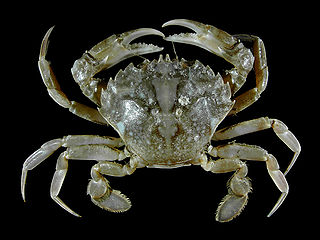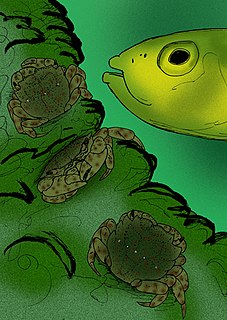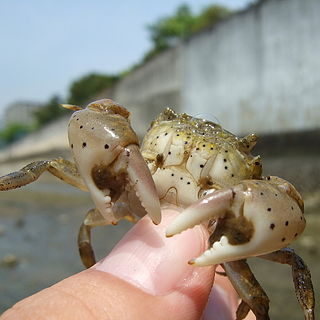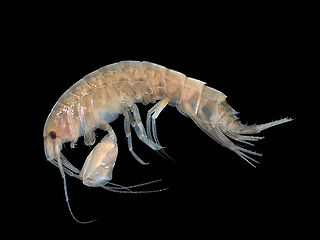
Crabs are decapod crustaceans of the infraorder Brachyura, which typically have a very short projecting "tail" (abdomen), usually hidden entirely under the thorax. They live in all the world's oceans, in fresh water, and on land, are generally covered with a thick exoskeleton and have a single pair of pincers. Many other animals with similar names – such as hermit crabs, king crabs, porcelain crabs, horseshoe crabs, and crab lice – are not true crabs.

Hermit crabs are decapod crustaceans of the superfamily Paguroidea.

Carcinus maenas is a common littoral crab. It is known by different names around the world. In the British Isles, it is generally referred to as the shore crab, or green shore crab. In North America and South Africa, it bears the name green crab or European green crab. In Australia and New Zealand, it is referred to as either the European green crab or European shore crab.

Hemigrapsus sexdentatus, known as the common rock crab, is a large-eyed marine crab of the family Varunidae, endemic to the coasts of New Zealand. However, it is not found in the Chatham Islands or the southern islands. It can grow to around 45 millimetres (1.8 in) (female) or 55 millimetres (2.2 in) (male) shell width.

Hemigrapsus crenulatus, the hairy-handed crab or papaka huruhuru, is a marine crab of the family Varunidae, endemic to the New Zealand coast, although a taxon in Chile may be conspecific.

The Varunidae are a family of thoracotrematan crabs. The delimitation of this family, part of the taxonomically confusing Grapsoidea, is undergoing revision. For a long time, they were placed at the rank of subfamily in the Grapsidae, but they appear to be closest to Macropthalmus and the Mictyridae, which are usually placed in the Ocypodoidea. It may thus be better to merge the latter superfamily with the Grapsoidea, retaining the latter name as it is older.

The purple shore crab, Hemigrapsus nudus, is a common crab of the family Varunidae. It can be found sheltering under rocks in inter-tidal areas along the west coast of North America, from Alaska to Baja California in Mexico. This crab primarily eats sea lettuce and other green algae, and occasionally scavenges dead animals.

Hemigrapsus oregonensis is a small shore crab of the family Varunidae; it was formerly classified under the family Grapsidae. It is known under several common names, including yellow shore crab, hairy shore crab, green shore crab, mud-flat crab, and Oregon shore crab.

Hemigrapsus takanoi, the brush-clawed shore crab or Asian shore crab, is a small crab of the family Varunidae that lives on rocky shores surrounding the Pacific Ocean, and which is invasive along the European coastlines. This crab is omnivorous and eats small fish, invertebrates and algae.
The common name yellow crab may refer to any of the following species:

Profilicollis is a genus of acanthocephalan parasites of crustaceans. The status of the genus Profilicollis has been debated, and species placed in this genus were formerly included in the genus Polymorphus. However, research on the morphology of the group and their use of hosts has concluded that Profilicollis and Polymorphus should be regarded as distinct genera, and species previously described as Polymorphus altmani are now referred to as Profilicollis altmani in the literature. Profilicollis parasites infect decapod crustaceans, usually shore crabs, as intermediate hosts, and use many species of shorebirds as definitive (final) hosts.

The question of whether crustaceans experience pain is a matter of scientific debate. Pain is a complex mental state, with a distinct perceptual quality but also associated with suffering, which is an emotional state. Because of this complexity, the presence of pain in an animal, or another human for that matter, cannot be determined unambiguously using observational methods, but the conclusion that animals experience pain is often inferred on the basis of likely presence of phenomenal consciousness which is deduced from comparative brain physiology as well as physical and behavioural reactions.
Purple rock crab is a common name which may apply to any of the following crab species:
Common rock crab may refer to any of the following species of crab:

Hemigrapsus estellinensis is an extinct species of crab, formerly endemic to the Texas Panhandle. It was discovered by Gordon C. Creel in 1962 and was probably already extinct before his description was published in 1964, after the Estelline Salt Springs where it lived were contained by the United States Army. H. estellinensis is closely related to species from the Pacific Ocean such as Hemigrapsus oregonensis, but lived 800 km (500 mi) inland in a hypersaline spring. It differed from its relatives by the pattern of spots on its back, and by the relative sizes of its limbs.

Hemigrapsus is a genus of varunid crabs comprising thirteen species native almost exclusively in the Pacific Ocean, but two have been introduced to the North Atlantic region.

Hemigrapsus penicillatus is a species of crab. The native range of Hemigrapsus penicillatus extends from the Russian Far East along the coasts of Japan, China, Taiwan and Korea, as far south-west as Hong Kong. Although the species was reported from Hawaii in 1903, this is likely to have been an error; there are no recent records of the species in the central Pacific. Reports of H. penicillatus on the coasts of Europe refer to a related species, H. takanoi, which was only distinguished from H. penicillatus in 2005, several years after its discovery in Europe. Hemigrapsus penicillatus lives in the intertidal zone on stony or muddy shores.

Crustaceans form a large, diverse arthropod taxon which includes such familiar animals as crabs, lobsters, crayfish, shrimps, prawns, krill, woodlice, and barnacles. The crustacean group is usually treated as a class under subphylum Mandibulata and because of recent molecular studies it is now well accepted that the crustacean group is paraphyletic, and comprises all animals in the Pancrustacea clade other than hexapods. Some crustaceans are more closely related to insects and other hexapods than they are to certain other crustaceans.
Polyascus is a genus of barnacles in superorder Rhizocephala. It was circumscribed in 2003 by Henrik Glenner, Jørgen Lützen, and Tohru Takahashi. They included three species, all transferred from Sacculina. The generic name polyascus refers to the typical presence of multiple external sac-like female bodies, known as externae. In Polyascus species, these originate from asexual reproduction.













